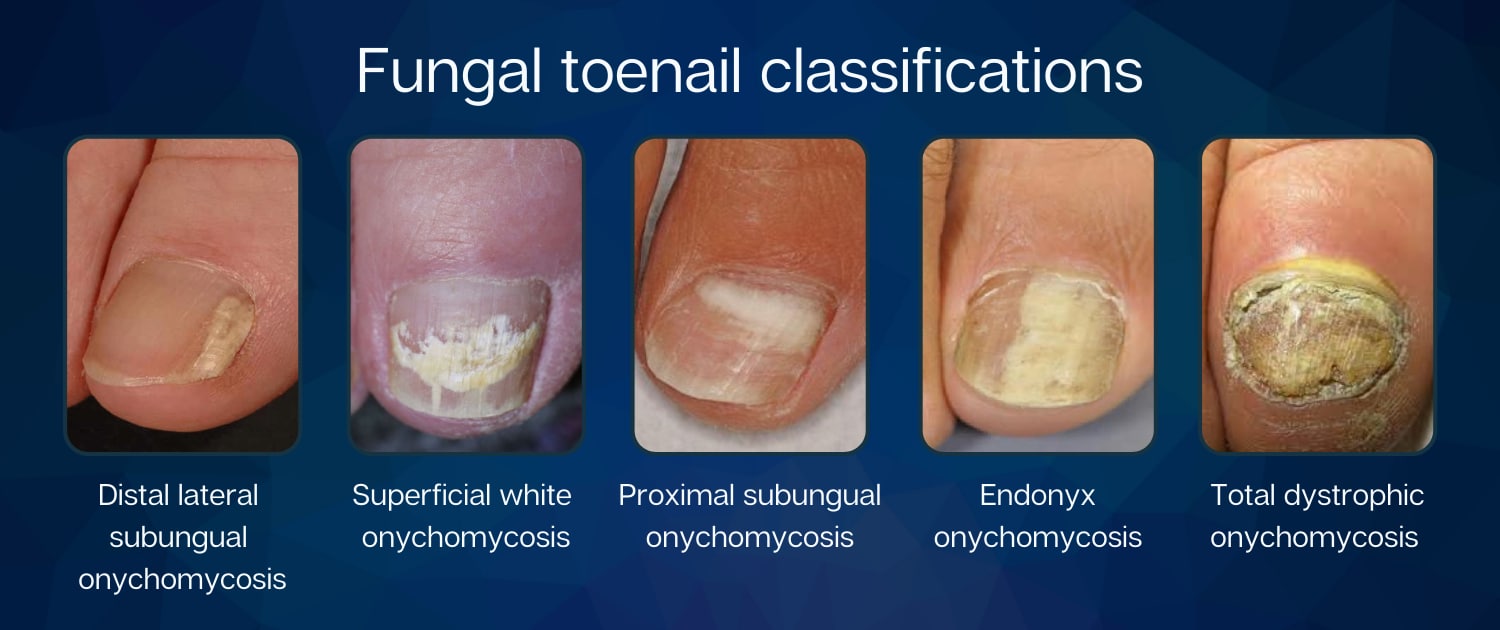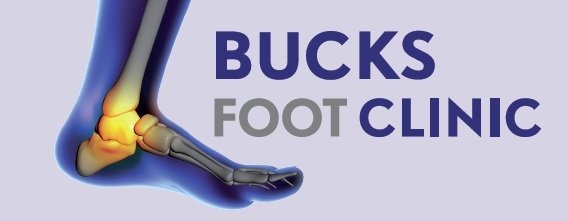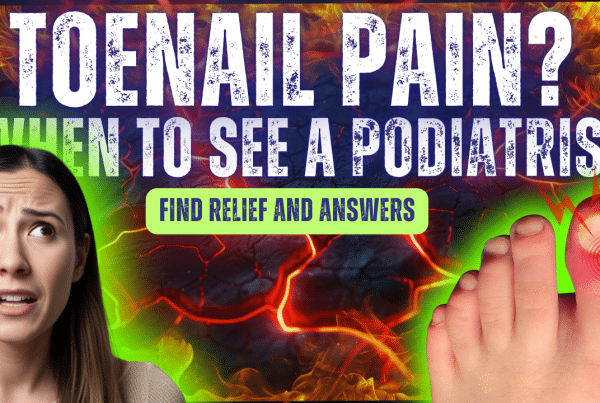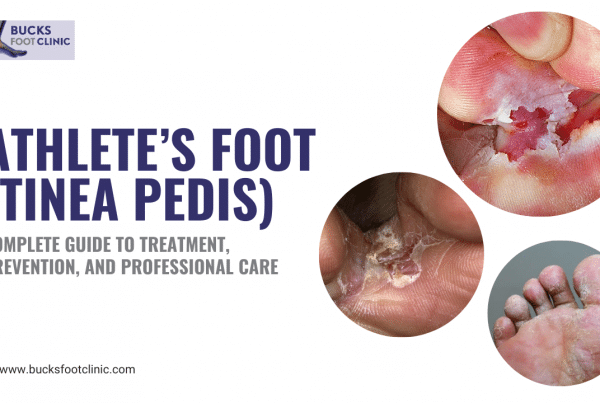
Understanding Toenail Fungus: Your Gentle Guide to Clear, Healthy Nails Again
Are you feeling embarrassed or frustrated by thick, discoloured toenails that seem to be getting worse despite your best efforts? We want you to know that you’re absolutely not alone in dealing with toenail fungus, and more importantly, there’s genuine hope for restoring your nails to health. At Bucks Foot Clinic, we’ve helped thousands of people overcome the challenge of onychomycosis, and we understand both the physical discomfort and emotional impact this condition can have on your life.
Toenail fungus affects approximately 10% of the UK population, yet many people suffer in silence, feeling too embarrassed to seek help or believing that nothing can be done. We want to change that narrative. With proper understanding, care, and professional onychomycosis treatment, you can absolutely achieve clear, healthy nails again. This comprehensive guide will walk you through everything you need to know with compassion, hope, and practical solutions.
What Is Toenail Fungus? Understanding Your Condition with Kindness
Toenail fungus, medically known as onychomycosis, is a common fungal infection that affects the nail and nail bed. Please understand that developing this condition doesn’t reflect poor hygiene or personal failings—fungal infections can happen to anyone, regardless of how carefully they care for their feet.
Think of fungal infections as opportunistic organisms that take advantage of the warm, moist environment inside your shoes. Just as plants grow in a greenhouse, fungi thrive in similar conditions. Your feet spend most of the day in this enclosed environment, making them naturally susceptible to fungal growth.
The Different Types of Toenail Fungus
Understanding the type of infection you have helps us choose the most effective onychomycosis treatment:
Distal Subungual Onychomycosis: The most common type, starting at the tip of the nail and working backward. You might notice yellowing or white discolouration beginning at the nail’s free edge.
Proximal Subungual Onychomycosis: Less common, starting near the cuticle and growing outward. This type often appears as white or yellow spots near the base of the nail.
White Superficial Onychomycosis: Creates white, chalky patches on the nail surface. This type is often easier to treat when caught early.
Candidal Onychomycosis: Usually affects fingernails but can occur on toenails, particularly in people with compromised immune systems.
Each type responds differently to treatment, which is why professional diagnosis is so valuable in achieving successful outcomes.
Recognising Toenail Fungus: The Signs Your Nails Are Asking for Help
Early recognition of toenail fungus symptoms can make treatment much more effective and less complex. We encourage you to think of nail changes as your body’s way of communicating that it needs attention, not as something to be ashamed of.
Visual Signs to Watch For
Discolouration: Your nails might develop yellow, brown, white, or even greenish tints. Remember, healthy nails can have natural variations in colour, so we’re looking for changes from your normal nail appearance.
Thickening: Fungal infections often cause nails to become noticeably thicker and more difficult to trim. This thickening is your nail’s response to the infection and often improves dramatically with proper treatment.
Texture Changes: Your nails might become brittle, crumbly, or develop a rough, uneven surface. Some people describe their nails as looking “chalky” or “powdery.”
Shape Distortion: Advanced infections can cause nails to become misshapen or separate from the nail bed. While this might look concerning, proper treatment can often restore normal nail growth.
Physical Symptoms
Odour: Some fungal infections produce a distinctive, unpleasant smell. This is completely normal with certain types of fungi and typically resolves with successful treatment.
Discomfort: While toenail fungus isn’t always painful, some people experience tenderness, especially when wearing tight shoes or during physical activity.
Nail Debris: You might notice a buildup of debris under the nail. This material is a combination of dead skin cells and fungal elements that accumulate as the infection progresses.
Why Toenail Fungus Develops: Understanding Without Judgment
Understanding why you developed toenail fungus isn’t about blame—it’s about empowerment. When you know the contributing factors, you can take steps to prevent recurrence and create the best environment for healing.
Environmental Factors
Warm, Moist Environments: Fungi thrive in warm, humid conditions. This includes public swimming pools, gym showers, changing rooms, and even your own shoes when they don’t have adequate ventilation.
Footwear Choices: Tight, non-breathable shoes create the perfect environment for fungal growth. This doesn’t mean you’ve made bad choices—many stylish shoes simply aren’t designed with fungal prevention in mind.
Occupational Hazards: Certain jobs increase exposure risk, including those requiring steel-toed boots, spending time in wet conditions, or working in warm environments.
Personal Risk Factors
Age: As we age, our circulation decreases and our immune response changes, making us more susceptible to fungal infections. This is a normal part of aging, not a personal failing.
Health Conditions: Diabetes, circulation problems, and immune system conditions can increase susceptibility. Having these conditions doesn’t guarantee you’ll develop toenail fungus, but it does mean extra care is beneficial.
Previous Injury: Nail trauma from sports, accidents, or ill-fitting shoes can create entry points for fungi. Even minor injuries you might not remember can predispose nails to infection.
Family History: Some people have a genetic predisposition to fungal infections. If family members have had similar problems, you might be more susceptible through no fault of your own.
The Emotional Impact: You’re Not Alone in Your Feelings
We want to acknowledge that toenail fungus affects more than just your physical health. Many of our patients express feelings of embarrassment, frustration, and even social anxiety about their nail appearance. These feelings are completely valid and understandable.
Common Emotional Responses
Self-Consciousness: Many people become reluctant to wear open-toed shoes, go barefoot at the beach, or participate in activities where others might see their feet. This isolation can significantly impact your quality of life and enjoyment of activities you once loved.
Frustration with Treatment: Previous unsuccessful treatment attempts can lead to feelings of hopelessness. Please know that treatment failures don’t mean your condition is untreatable—they often mean the wrong treatment was tried or wasn’t continued long enough.
Impact on Relationships: Some people worry about their partner’s reaction or feel embarrassed during intimate moments. Remember, loving relationships can weather health challenges, and addressing the problem shows self-care and consideration for your wellbeing.
Building Confidence Through Treatment
Every step you take toward treating your toenail fungus is a step toward regaining confidence. Many patients tell us that successful treatment has improved not just their nail health but their overall sense of wellbeing and willingness to engage in social activities.
Professional Onychomycosis Treatment: Why Expert Care Makes All the Difference
There’s a profound difference between attempting self-treatment and receiving professional onychomycosis treatment, and understanding this difference could save you months or even years of ineffective treatment attempts.
The Diagnostic Advantage: Confirming What You’re Actually Treating
Not all nail problems are fungal infections. Conditions like psoriasis, eczema, bacterial infections, and even nail trauma can create symptoms that look very similar to toenail fungus. Professional diagnosis ensures you’re treating the right condition with the most appropriate therapy.
Laboratory Testing: Professional diagnosis often includes laboratory analysis of nail samples to identify the specific type of fungus involved. Different fungi respond to different treatments, so knowing exactly what you’re dealing with allows for targeted, effective therapy.
Comprehensive Assessment: A professional evaluation examines your overall foot health, circulation, and any contributing factors that might affect treatment success. This holistic approach significantly improves treatment outcomes.
Advanced Treatment Options Available Only Through Professional Care
Prescription Medications: Professional onychomycosis treatment includes access to prescription antifungal medications that are far more effective than over-the-counter options. These medications are specifically formulated for nail fungus and have success rates significantly higher than generic treatments.
Laser Therapy: Modern laser treatments can penetrate the nail to target fungal organisms directly. This innovative approach often works when traditional treatments have failed and typically has fewer side effects than oral medications.
Combination Therapy: Professionals can combine multiple treatment modalities for enhanced effectiveness. This might include topical medications, oral treatments, and supportive therapies tailored to your specific situation.
Nail Removal When Appropriate: In severe cases, partial or complete nail removal might be recommended to allow direct treatment of the nail bed. This procedure is performed safely and comfortably in a clinical setting with proper pain management and aftercare.
The Precision of Professional Treatment
Proper Application Techniques: Professional treatments are applied with precision, ensuring maximum penetration and effectiveness. The way medication is applied can significantly impact treatment success.
Monitoring and Adjustment: Professional care includes regular monitoring of treatment progress and adjustment of therapy as needed. This ongoing supervision helps ensure you’re always receiving the most effective treatment for your current situation.
Managing Side Effects: When they occur, side effects from treatment can be properly managed by healthcare professionals. This medical oversight ensures your safety and comfort throughout the treatment process.
The Critical Importance of Proper Onychomycosis Treatment
Why getting toenail fungus treated correctly isn’t just about appearance—it’s about preventing serious complications that could affect your foot health and overall wellbeing for years to come.
The Progression Problem: Why Waiting Makes Treatment Harder
Fungal infections don’t improve on their own—they typically worsen over time. What starts as a small discoloured area can eventually affect the entire nail and spread to other nails. Early professional intervention is always more successful and less complex than treating advanced infections.
Structural Damage: Advanced toenail fungus can permanently damage the nail matrix (the area where new nail grows). This damage can result in permanently deformed nails even after the infection is cleared.
Spread to Other Areas: Untreated nail fungus can spread to other nails, the skin of your feet (athlete’s foot), and even to other people through shared surfaces. Professional treatment stops this progression and prevents transmission.
Secondary Complications
Bacterial Infections: Damaged nails from fungal infections can become entry points for bacteria, leading to more serious infections that might require antibiotic treatment or even hospitalisation.
Pain and Mobility Issues: Severely thickened or distorted nails can cause pain when walking or wearing shoes, potentially affecting your gait and leading to other foot, knee, or back problems.
Diabetic Considerations: For people with diabetes, any foot infection poses increased risks. Professional onychomycosis treatment is particularly important for maintaining overall foot health in diabetic patients.
The Treatment Success Timeline
Understanding realistic timelines helps set appropriate expectations and encourages adherence to treatment protocols:
Initial Improvement: With effective treatment, you might notice improvements in nail texture and reduced debris within 4-6 weeks.
Visible Progress: Significant visual improvement typically becomes apparent after 3-4 months of consistent treatment.
Complete Clearance: Full nail clearance can take 6-12 months or longer, depending on the severity of infection and how quickly your nails grow.
The key to success is consistency and patience. Professional monitoring ensures you stay on track and make adjustments when needed.
Comprehensive Prevention: Protecting Your Investment in Healthy Nails
Once you’ve achieved clear, healthy nails, prevention becomes crucial for maintaining your results and protecting the time and effort you’ve invested in treatment.
Environmental Management
Shoe Hygiene: Regularly disinfect the inside of your shoes with antifungal sprays or UV sanitizers. Consider having multiple pairs of shoes so you can rotate them and allow complete drying between wears.
Sock Selection: Choose moisture-wicking, breathable socks and change them daily—or more frequently if your feet sweat heavily. Anti-fungal socks are available and can provide additional protection.
Home Environment: Keep your feet dry and clean, especially between toes. Use separate towels for your feet and wash them in hot water regularly.
Public Space Precautions
Protective Footwear: Always wear flip-flops or shower shoes in public areas like pools, gyms, and changing rooms. Never walk barefoot in these environments, even briefly.
Personal Items Only: Don’t share shoes, socks, towels, or nail care tools with others. Fungal spores can survive on these items and cause reinfection.
Nail Care Best Practices
Proper Trimming: Keep nails trimmed straight across and not too short. Use clean, disinfected nail tools and consider having separate tools just for your feet.
Regular Monitoring: Continue to inspect your nails regularly for any signs of recurrence. Early detection allows for prompt treatment before problems become established.
5 Key Action Points for Effective Toenail Fungus Management
Here are five crucial steps you can take immediately to begin addressing your toenail fungus and supporting your journey to healthy nails:
- Document and Assess Your Current Condition
Take clear, well-lit photographs of all affected nails from multiple angles. Note any symptoms like odour, pain, or debris. Measure the affected area if possible by noting what percentage of each nail appears infected. This documentation will be invaluable for tracking treatment progress and will help healthcare providers assess your condition accurately. Create a simple log noting when you first noticed changes and any treatments you’ve already tried.
- Implement Immediate Environmental Changes
Begin antifungal prevention measures today, even before starting treatment. Spray your shoes with antifungal products, replace old socks with moisture-wicking varieties, and never walk barefoot in public areas. Purchase shower shoes for gym and pool use immediately. If you share living space, inform household members about prevention measures to protect everyone’s foot health.
- Establish a Daily Foot Care Routine
Wash your feet daily with antifungal soap, dry them completely (especially between toes), and apply over-the-counter antifungal powder or cream to prevent spread. Keep nails clean and trimmed but avoid aggressive cutting or manipulation that could cause injury. Replace your towels and washcloths more frequently during this period.
- Research and Prepare for Professional Treatment
Contact Bucks Foot Clinic to schedule a comprehensive evaluation. Prepare for your appointment by listing all medications you take, previous treatment attempts, and any health conditions that might affect treatment choices. Ask about different treatment options available and what to expect during the treatment process. Don’t delay this step—early professional intervention significantly improves treatment outcomes.
- Create Your Support System and Treatment Plan
Inform family members about your condition and prevention measures to prevent household transmission. Set realistic expectations for treatment timeline and prepare for the commitment required for successful onychomycosis treatment. Consider the practical aspects like medication costs, appointment scheduling, and any temporary activity restrictions that might be recommended during treatment.
Understanding Treatment Options: From Conservative to Advanced
Topical Treatments
Over-the-Counter Options: While less effective than prescription treatments, some people benefit from consistent use of antifungal creams, ointments, or solutions. These work best for very early, superficial infections but often require months of consistent application.
Prescription Topical Medications: Professional-strength topical treatments can penetrate nails more effectively and have higher success rates. These medications are formulated specifically for nail fungus and often include penetration enhancers.
Oral Medications
Prescription Antifungals: Oral medications can be highly effective, particularly for multiple nail infections or thick, severely affected nails. These treatments work from inside your body to fight the infection systemically.
Monitoring Requirements: Oral antifungal medications require periodic blood tests to monitor liver function. This medical oversight ensures your safety while maximizing treatment effectiveness.
Advanced Treatment Modalities
Laser Therapy: Uses focused light energy to heat and destroy fungal organisms in the nail. This treatment is particularly appealing for people who cannot take oral medications due to health concerns.
Photodynamic Therapy: Combines special medications with light therapy to target fungal cells specifically. This innovative approach can be effective when other treatments haven’t worked.
Surgical Options: In severe cases, partial or complete nail removal might be recommended. Modern surgical techniques minimize discomfort and promote faster healing.
The Science Behind Successful Treatment
Understanding how different treatments work helps you make informed decisions about your onychomycosis treatment:
How Fungi Survive in Nails
Nail Structure: The nail plate is made of tightly packed keratin that creates a protective barrier. Unfortunately, this same barrier that protects your nail bed also protects fungi once they establish infection.
Fungal Biology: These organisms can survive in harsh conditions and grow slowly, which is why treatment must be sustained over long periods. They can remain dormant and become active again if conditions become favourable.
Why Professional Treatment Is More Effective
Penetration Technology: Professional treatments use advanced formulations and application techniques that improve medication penetration through the nail barrier.
Combination Approaches: Professional care can combine multiple treatment modalities to attack the infection from different angles simultaneously.
Monitoring and Adjustment: Regular professional assessment allows for treatment modifications based on your response, ensuring optimal outcomes.
Special Considerations for Different Populations
For Diabetic Patients
Enhanced Risk: Diabetes increases both the likelihood of developing toenail fungus and the potential for serious complications. Professional monitoring is essential for diabetic patients with any foot conditions.
Treatment Modifications: Some medications used for toenail fungus might interact with diabetes medications or require special monitoring in diabetic patients. Professional oversight ensures safe, effective treatment.
For Older Adults
Age-Related Changes: Slower nail growth and reduced circulation can affect both treatment success and healing times. Professional treatment plans account for these factors to optimize outcomes.
Medication Considerations: Older adults often take multiple medications that might interact with antifungal treatments. Professional evaluation ensures compatibility with existing medication regimens.
For Athletes and Active Individuals
Continued Activity: Treatment plans can be modified to accommodate training schedules and competition requirements. You don’t have to stop being active while treating toenail fungus.
Prevention Strategies: Athletes need enhanced prevention strategies due to increased exposure to fungal environments. Professional guidance helps maintain foot health while pursuing athletic goals.
Your Journey to Healthy Nails Starts Today
Dealing with toenail fungus doesn’t define you, and it certainly doesn’t have to limit your life indefinitely. With proper understanding, professional onychomycosis treatment, and consistent care, you can absolutely achieve the clear, healthy nails you deserve.
Remember that successful treatment is a process, not an event. Be patient with yourself, celebrate small improvements, and trust in the process. Every day of proper treatment brings you closer to your goal of clear, healthy nails that you can feel confident showing.
The combination of professional expertise, advanced treatment options, and your commitment to the process creates the optimal environment for success. You don’t have to navigate this journey alone, and you certainly don’t have to accept ongoing embarrassment or discomfort as normal.
Don’t let another day pass feeling self-conscious about your nails. The experienced team at Bucks Foot Clinic understands exactly what you’re going through, and we’re here to help you achieve the clear, healthy nails you deserve. Call us today at 01494 434 366 to schedule your comprehensive toenail fungus evaluation. Together, we’ll create a personalised treatment plan that addresses your specific needs and gets you back to feeling confident about your feet.
Your journey to healthy, clear nails begins with a single step—reaching out for the professional care that can make all the difference. You deserve to feel comfortable and confident in your own skin, and we’re here to help you achieve exactly that.
Ready to say goodbye to toenail fungus forever? Contact Bucks Foot Clinic at 01494 434 366 and let our caring, experienced team guide you back to the clear, healthy nails that will restore your confidence. Your feet—and your peace of mind—are worth this investment in your health and happiness.
Toenail Fungus – FAQs
Q: What is toenail fungus?
A: It is a fungal infection of the toenail and nail bed that causes changes in colour, thickness, and texture.
Q: What are the common signs of toenail fungus?
A: Discoloured nails, thickening, brittleness, crumbling, nail lifting, debris under the nail, and sometimes an unpleasant smell.
Q: What causes toenail fungus?
A: Fungi thrive in warm, moist environments and enter through small breaks in the nail. Risk factors include damp shoes, tight footwear, diabetes, and reduced circulation.
Q: Is toenail fungus painful?
A: It may not be painful at first, but thick or misshapen nails can cause discomfort over time.
Q: How is toenail fungus diagnosed?
A: A healthcare professional examines the nail and may take a sample to confirm the infection.
Q: How is toenail fungus treated?
A: Treatment may include antifungal medication, professional nail trimming, and long-term care as the nail grows out.
Q: Can toenail fungus go away on its own?
A: No. Without treatment, it usually persists or worsens.
Q: How long does treatment take?
A: Treatment can take several months because toenails grow slowly.
Q: Can toenail fungus spread?
A: Yes. It can spread to other nails or surrounding skin if not treated.
Q: How can toenail fungus be prevented?
A: Keep feet clean and dry, change socks daily, wear breathable shoes, and avoid sharing nail tools.



